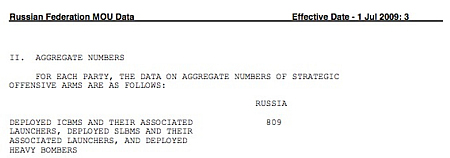New START Data Exchange: Will it Increase or Decrease International Nuclear Transparency?
 |
| U.S. officials say that aggregate numbers of the New START treaty will be made publicly available but that these may be very general numbers and a decision still has to be made. For a copy of the final START aggregate numbers, click here. |
.
By Hans M. Kristensen
The first data exchange of the New START treaty between the United States and Russia has taken place, according to a report by RIA Novosti.
This is the first of more than 20 such data exchanges planned under the treaty for the next 10 years where Russia and the United States twice a year will send each other a list showing how many long-range ballistic missiles and heavy bombers they have and how many nuclear weapons they carry.
But while the exchanges will increase U.S-Russia nuclear transparency, the rest of the world may be facing a future with less information about U.S. and Russian strategic nuclear forces than in the past.
“All exchanges are classified and will not be subject to release,” a U.S. official told me. “There may be some information on very general numbers under the Treaty that could be made public, but that is still to be determined, and will not occur for a least six months if it occurs at all.”
Previous Nuclear Transparency
During the previous START treaty regime between 1994 and 2009, the two countries also exchanged data. That data was classified but the two sides released so-called aggregate numbers biannually to the public (the final START release is here]. Rose Gottemoeller, the U.S. Assistant Secretary for the Bureau of Arms Control, Verification and Compliance, assured early on that “data on the aggregate number of warheads each Party deploys on ICBMs and SLBMs will be exchanged and made publicly available” for New START as well. (Emphasis added)
Hopefully that will happen, but the aggregate numbers release was based on a much larger document – the Memorandum of Understanding (MOU) – exchanged between the two countries twice a year. The unclassified MOU was not published because (I was told) of Russian objections, but the United States would – upon request – release the MOU, which provided much more detailed data for each nuclear weapon and facility.
| START July 2009 Memorandum of Understanding |
 |
| The first START treaty provided the public with detailed overviews of U.S. and Russian strategic nuclear forces. Will New START do so as well or decrease international nuclear transparency? To down copy of the final START MOU, click here. |
.
The MOU provided important information for the international community to monitor the development of U.S. and Russian long-range nuclear forces. But the official statements made so far suggest that such detailed information might not be released under New START.
Implications and Recommendations
The New START treaty is widely seen as a first step in a process that seeks to involve other nuclear weapon states in future nuclear arms control negotiations. As such, it is important that the United States and Russia continue to make detailed information on the status of their nuclear forces available to the international community.
At the very least, this should include the aggregate numbers – including breakdown by individual nuclear weapon systems. But it should also continue the practice of releasing the full unclassified MOUs to increase international transparency and predictability in nuclear forces. Doing anything else would be a step back that could create mistrust and undercut a broadening of the nuclear arms control progress to other nuclear weapon states.
Each new step in the arms control process must increase transparency, not reduce it.
This publication was made possible by a grant from Carnegie Corporation of New York and Ploughshares Fund. The statements made and views expressed are solely the responsibility of the author.
The FY2026 National Defense Authorization Act (NDAA) paints a picture of a Congress that is working to both protect and accelerate nuclear modernization programs while simultaneously lacking trust in the Pentagon and the Department of Energy to execute them.
While advanced Chinese language proficiency and cultural familiarity remain irreplaceable skills, they are neither necessary nor sufficient for successful open-source analysis on China’s nuclear forces.
Satellite imagery has long served as a tool for observing on-the-ground activity worldwide, and offers especially valuable insights into the operation, development, and physical features related to nuclear technology.
This report outlines a framework relying on “Cooperative Technical Means” for effective arms control verification based on remote sensing, avoiding on-site inspections but maintaining a level of transparency that allows for immediate detection of changes in nuclear posture or a significant build-up above agreed limits.